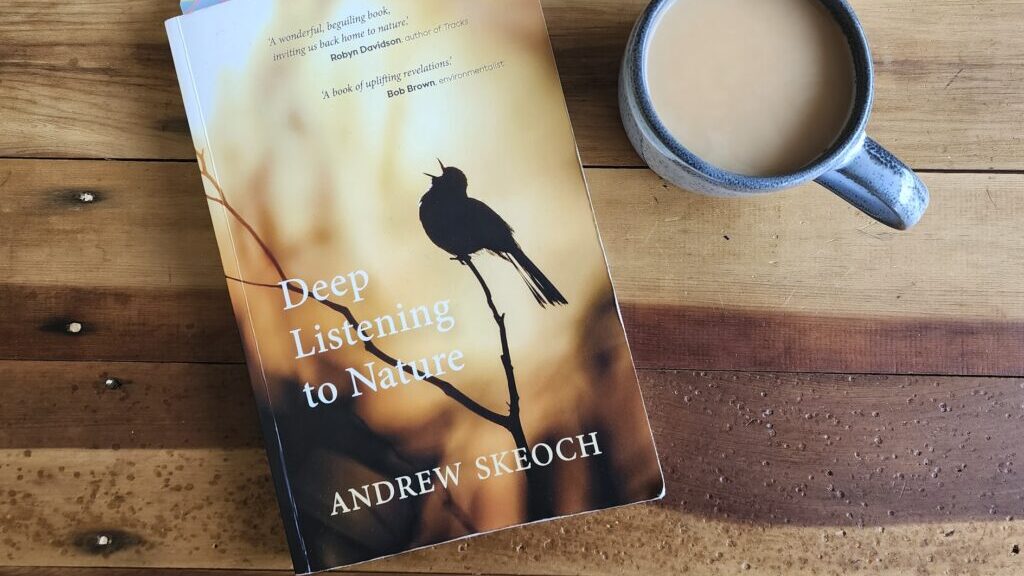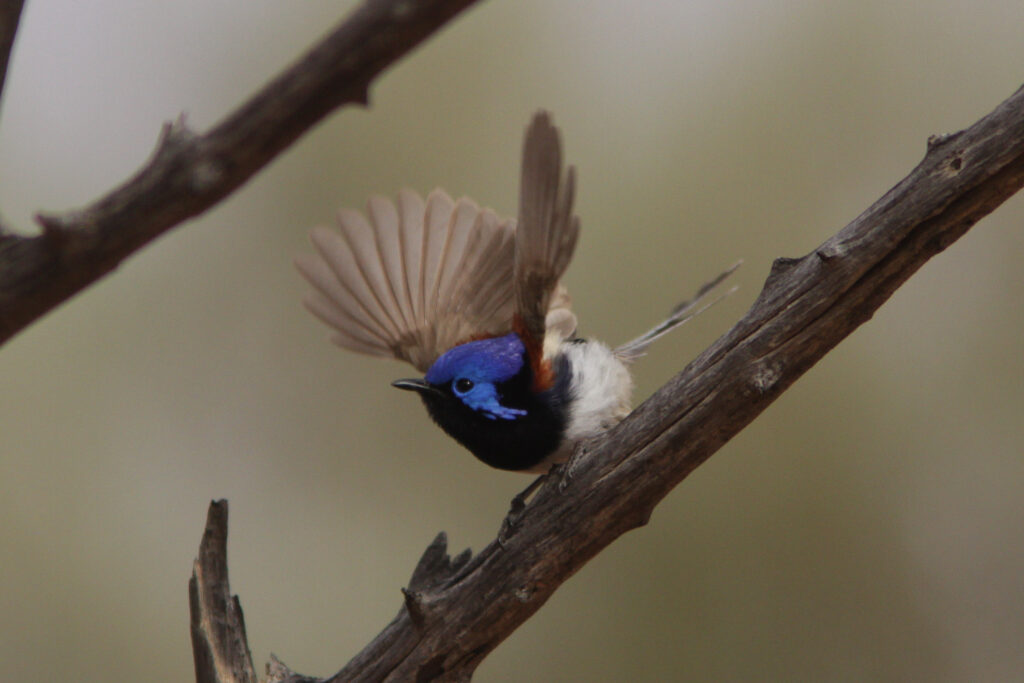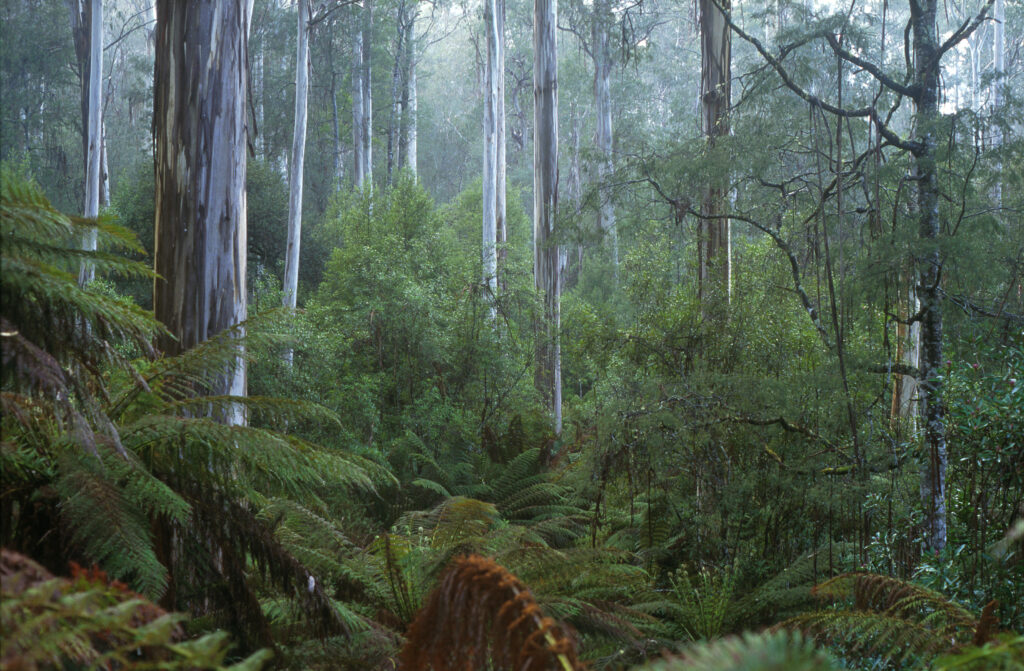

I’m walking down into a gully on the lands of the Dja Dja Wurrung. It is a misty morning, the winter sun yet to burn off the dew of the night before. The bush is quiet, muted. But here and there I hear the cough of a Red Wattlebird, the titters of thornbills, and the ringing call of a Grey Fantail singing; “I’m a pretty fan-tail!”. A flock of White-winged Choughs, startled by our arrival, ascend to the trees and lift a chorus, their wailing cries floating down all around us.
I’m here with renowned sound recordist, Andrew Skeoch, and today I am hoping he will teach me how to listen.
Andrew Skeoch represents one-half of Listening Earth, an Australian record label dedicated to capturing and sharing nature’s soundscapes. The other half is photographer Sarah Koschak, Andrew’s partner in life and business. For the last thirty years, the pair have been travelling the world, recording natural soundscapes from Australian outback waterholes to the cloudforests of Malaysia, from Scandinavian Taiga bogs and Turkey’s Taurus Mountains to the rainforests of Zanzibar. Listening Earth has published more than 100 soundscape albums, sharing the aural magic of nature with tens of thousands of listeners on streaming platforms every month.
After three decades of listening, Andrew has developed an intimate understanding of nature and what it can tell us, if we pay attention. In his new book, Deep Listening to Nature Andrew shares his knowledge with us. Through his stories, listening tips, and philosophy, Andrew emphasises the importance of deep listening for humans, for nature, and for each other. It is an invitation to listen, for our own health, and that of the planet.
When did you last really listen to someone, to something? Andrew says hearing is a really under-appreciated sense, one of the key ways that we have evolved to understand and respond to our world.
Our brains are wired to the ancestral importance of sound, listening in for the information contained in speech, music, rustling leaves or animal communications. But, as Andrew explains, our modern, urban environments are uncomfortably full of “anthropogenic noise – traffic, machinery, aircraft – characterised as low information sound. There is nothing engaging, interesting or useful about it, so the brain tries to filter it out. And while we’re extraordinarily good at filtering out information that isn’t of interest to us, it does take a bit of processing power.” Andrew likens the neurological effort needed to filter noise to the lengthy, memory-heavy processing his computer has to undertake to clean human noises from his nature recordings. Importantly, the evidence is that this constant sensory filtering fatigues and stresses us. Perhaps that’s why so many of us walk around with headphones on.
But how much are we tuning out? Andrew reflects on the time he has spent with Indigenous communities and cultures across the globe, saying, “you realise just how tuned in they are to sound. They’re aware of how much it tells them, about the world around them.” Andrew thinks of these cultures as ‘listening peoples’ and explains that the rest of us are losing access to important information from the more-than-human world in which we evolved. “Our distant ancestors spent 100% of their lives in that sound world and their mental processing was attuned to that. We’ve inherited that capacity, but by virtue of our lifestyle, we’ve lost our natural ability. But it is still there, and we can recover it”.
Phew, that’s a relief! According to Andrew, we need to be listening because nature has so much to tell us.

As Andrew travelled the acoustic world and refined his listening and recording techniques, he started to develop a deeper understanding of sound, and how nature uses it. He began to realise the depth of information sound reveals about landscapes and communities, their health and resilience. Also, that sound facilitates cooperation and collaboration, providing ways to avoid conflict and harm.
In Deep Listening to Nature, Andrew writes of the diplomacy of the dawn chorus, “one of nature’s most sophisticated processes of negotiation – both between species, and among members of the same species.” Rather than shouting over one another, birds have developed sonic strategies and acoustic behaviours that provide spaces for other voices. These acoustic adaptations are paralleled in the chorusing of frogs.
Listening to one another allows animals to share information about threats and resources, within and between families, species and communities. Like the ringing, high-pitched calls many honeyeaters give in response to the sight of an aerial predator, or the harsh multi-species scolding that follows any python or monitor lizard on the hunt for eggs and nestlings. Quiet, high-pitched twitters keep mixed flocks of small bush-birds together as they forage, and the deep ventriloquial ‘oooms’ of Bronzewing Pigeons allow intraspecies communication while keeping predators in the dark.
Eavesdropping on these interactions reveals the agency and sentience of the animals around us, surprising us with the depth of their relationships and the complexity of their existence. But even more than that, Andrew says that nature is providing us with the blueprint to survive ourselves. “In our social systems, we prioritise the ideal of competitiveness, that competition is natural and necessary and good. That it brings out the best in us, and always leads to the optimal outcomes. And I’m looking around the world and going, ‘really?’, because it doesn’t seem like that to me!”
“Communication is used to avoid harm, to facilitate interactions without causing harm. And I thought, if we’re to learn anything from listening to nature, it’s in the complexity, richness and integrity of those interactions. If you lose species, you’re losing voices, and the whole thing starts falling apart. Understanding the function of communication in nature helps us appreciate the importance of communication to us as humans, because we’re communicating animals. The processes of nature that have evolved over time through natural selection, tell us what works and what doesn’t. Communication works. Avoiding harm works. Cooperation works, and creating rich systems works. How can we mimic nature’s processes to achieve a similar sustainability?
Andrew says that initially, Sarah and he felt the focus of Listening Earth was in promoting natural values and conservation awareness. But during the horror of the Black Summer bushfires, they questioned the significance of their recording work. “We’d be looking at the fire maps and tuning into the news and feeling heartbroken, because so many of the places that I had recorded over the years in Australia were going up in flames. Some of these places were precious to me as they had featured in my own journey of listening. Suddenly, in the space of a few weeks, these places were being completely overwhelmed by flames. I knew that the mortality rate was huge, and that these environments would very likely not regenerate into the kind of biodiversity and richness that I had experienced. The grief was just too big to really take in. I felt heartbroken. You know, I’ve lost friends in my life. But it felt like, this wasn’t like losing just one friend, but losing a whole community of them at once. I reflected that, after all these years I’ve been recording, what is the point when an entire ecosystem can just go up in flames like this? What’s the value of what I’m doing – particularly with people listening to those recordings in future, maybe not even aware that some of these places no longer exist?”
It was then that Andrew started writing Deep Listening to Nature as an invitation to develop our own listening awareness to the natural world, and to live more closely in accordance with the systems and values that work in nature.

The importance of listening to nature cannot be understated, both for the survival of our species, and for our individual health and wellbeing. Andrew says, “to listen to nature you have to slow your mind down and maintain awareness, and that’s essentially meditation. It’s hugely beneficial”. I know this from my own experience, but the science backs it up too. Listening to nature has proven benefits for human health and wellbeing, including alleviating stress and irritation, decreasing pain, lowering heart rate and blood pressure, boosting mood and improving cognitive performance.
To tune in to nature, we don’t have to listen all day, every day. Andrew says just ten or fifteen minutes of deep listening is immensely beneficial. “If you can maintain attention for that amount of time, that’s great! And the beauty of it is that in nature there is so much to attend to. When you begin listening, you might notice a couple of sounds. After a while, you realise there are a whole lot of things going on that you weren’t aware of at first. Nature slowly reveals itself as your awareness and attention grows. All this puts the mind in a very different space than our modern world usually requires, and that alone is enormously helpful. Importantly, in the process of listening, you’re developing an awareness of yourself as part of your surroundings, shifting out of the human world into feeling yourself as a living breathing animal in the environment, perceiving it, being aware of it, interacting with it, feeling calm, peaceful, fascinated, curious, excited. It’s like you’re bringing yourself alive and you’re giving yourself a different context for who you are in the world. And that is absolutely necessary to shifting our culture. We have the opportunity to become listening peoples.”
The sun has broken through now, and Andrew and I are delighting in the lively activity of honeyeaters in the canopy as they sip nectar, sally insects from the air and glean sugary lerps from the Yellow Gum leaves. I try to keep up as Andrew points out their various calls – Fuscous Honeyeater, Yellow-faced, White-eared, White-naped. A sun shower drifts down through the honeyed air, onto a celestial carpet of gum blossom – delicate blooms ripped from the canopy by the exuberant foraging of lorikeets.
Later, on the couch, halfway through Andrew’s book, I recognise some of the same calls in my own Central Victorian garden. I feel connected to these birds, and to my new home. A feeling of immense gratitude washes over me, and a hope that the rest of the world finds Deep Listening to Nature. We each have so much to gain from learning to listen.
Deep Listening to Nature by Andrew Skeoch is available at the Listening Earth website.
Let go of the human world
Take the earbuds out!
As silly as it sounds that’s probably a good starting point. Turn off your devices
and mentally disengage from the human world for a little while.
Allow nature to adjust to your presence
When you go out into a natural place, stop and be aware of yourself in that place, with your feet on the ground.
Be aware that as much as you are regarding the world around you – listening, tuning in – the world around you is tuning into you too. You’re a living thing, you’ve walked into the presence of nature and nature needs a little bit of time to get to know you. It is a beautiful process to think of yourself as being known by nature. That the birds and animals will get used to your presence, and the quality of your presence will allow them to just carry on doing what they are doing or not. Your quality of presence dictates to an extent their behaviour as well.
Sensing in 360 degrees
Stand in one place and begin listening. Do a 360-degree scan, listening to sounds all around you. Don’t move your head in the process, just keep still but scan your awareness all around, plus above and below. Listen to where sounds are coming from and conversely listen to the spaces where there doesn’t seem to be much sound. Silences in nature have a presence all of their own.
Listening to distance
Then you can start listening to distance, sounds originating from close up and far away. Try and listen for the furthest sounds you can here. Feel out your acoustic horizon, your circumference of perception. You might be able to hear further in one direction than another, depending on topography and the features of the landscape around you.
Try and get a sense of how sound changes over distance. What you’re hearing as the sound becomes muted and becomes more smudged with distance. If you’re listening to animal sounds, hear how they can be sharp and clear up close but become more toneful, more melodic with distance. Some quiet and intimate sounds become lost quickly, while others that keep widespread communities in touch can carry surprising distances in the landscape.
Listen for the texture of sounds; between rough, grating, atonal sounds and more melodic, tuneful, whistling kind of calls. Notice how the weather and time of day affects the transmission of sound through the atmosphere, transmitting further in the cool temperatures of dawn than later in the day.
Learn about species, voices, and behaviours
Once you have explored your spatial perception of sound, and get tuned in to the textures and tonalities of sound, THEN you can start getting curious about what you’re actually hearing. This is when you can begin thinking about what species it might be, and the kind of behavioural associations of particular sounds of a particular species, their repertoire and behaviour.
Banner image courtesy of Cathy Cavallo. All other images courtesy of Listening Earth – Andrew Skeoch and Sarah Koschak.